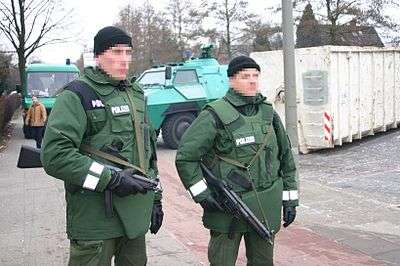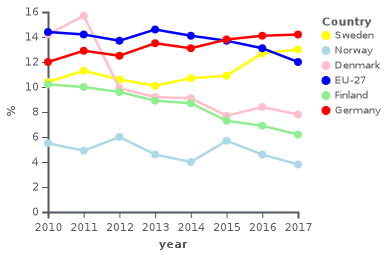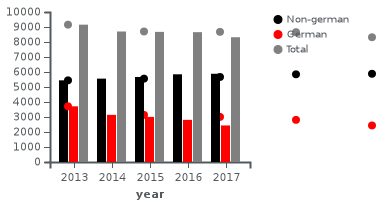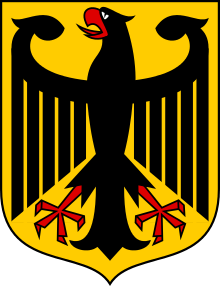Crime in Germany
Crime in Germany is combated by the German Police and other agencies.

Recent trends
Statistics
The official statistics PKS 2018 of 2018 by the Bundeskriminalamt for the year 2017 shows an increase of 39.9% for resistance and attacks against state authority, 13.6% in the spreading of pornographic material, 8.3% in crimes against the german drug law, 6.1% for narcotic-related crimes generally and 5.5% in violations of the german arms law.
On the other hand, there is a decrease by 18.2% in sexual assault, rape, sexual harassment including cases with lethal consequences, 16.3% in burglaries, 9.3% in violations of the immigration laws, 7.6% in fraud, 7.5% in theft and 6% in street crime.[1]
European Union Statistics on Income and Living Conditions (EU-SILC)
|
Share of population experiencing crime, violence or vandalism in their living area | |
 | |
| Source: EU-SILC[2] and Statistics Sweden[3] | |
In the EU-SILC survey, respondents were questioned about whether they experienced problems with violence, crime, or vandalism in the area where they live. Between 2010 and 2017, the EU crime average dropped by 3%. All countries in the EU except Germany, Sweden, and Lithuania showed a falling trend of criminal incidents.[3]
By type
According to Germany's 2010 crime statistics, 5.93 million criminal acts were committed, which was 2% lower than in 2009.[4] According to the Interior Ministry, this was the first time the figure had fallen below six million offenses since 1991 (the year after reunification), and is the lowest crime level since records began.[4] The rate of crimes solved in 2010 was 56%, a record high from 2009's 55.6%.[4]
In 2010, internet-related crime climbed 8.1%, with around 224,000 reported cases.[4] The number of house burglaries in 2010 also increased by 6.6%.[4]
Domestic violence
According to 2015 statistics, there were 127,000 victims of domestic violence. (German: Häusliche Gewalt) 82% of the victims were female. This represented an increase of 5.5% over 2012 statistics. The most commonly reported crime was bodily harm, defined as a slap or a strike of sufficient force to warrant prosecution. Other common crimes were threats (14.4%), grievous bodily harm (German: schwere Körperverletzung), and injury with a deadly outcome (German: Verletzung mit Todesfolge) at 12%. A fourth of the suspects were reported to be intoxicated from the consumption of alcohol.[5]
Murder
In 2016, Germany had a murder rate of 1.18 per 100,000 population.[6]
Organized crime
| Number of suspects in organized crime in Germany | |
 | |
| Source: BKA[7] | |
In the 1990s, the power balance changed in the red light districts of Germany when Russian, Yugoslav, Albanian and Kurds started to operate. In parts of Germany, police asked themselves whether they had suppressed German gangs too much as the gangs that took over were foreign and more brutal gangs.[8]
In 2017, statistics suggested that German citizens constitute the largest group of suspects in organized crime trials. From 2016 to 2017, the proportion of non-German citizen organized crime suspects increased from 67.5% to 70.7%. 14.9% of the German citizens involved held different citizenship at birth.[7]
Arab mafia
Die Welt reported in 2016 that Berlin and Bremen have significant problems with organized crime in the form of "Arab Families", of which seven to nine[9] are criminally conspicuous and today "dominate the bulk of organized crime." In another article, Die Welt claimed that prostitutes in the Schöneberg neighborhood are controlled by one family, with German pimps paying them protection money.[10]
Italian organized crime
The 'Ndrangheta, Camorra, and Cosa Nostra all operate in Germany. The 'Ndrangheta has the most robust presence. There are an estimated 1,200 members of the 'Ndrangheta active in Germany, mostly in the cocaine trade. Apart from the 'Ndrangheta, the Neapolitan Camorra has also infiltrated the construction industry in Germany. Five Sicilian Mafia groups are active in the country, but seem to have lost power.[11] Italian crime groups can mostly be found in the Ruhr district and in the west of Germany.
In December 2018, German police conducted an operation against the 'Ndrangheta in Germany and arrested 90 suspects for suspected drug dealing and money laundering. Forty-seven suspects were prosecuted.[12]
Outlaw motorcycle gangs
OMCGs such as Hells Angels, Bandidos, Gremium and more recently, Satudarah and Night Wolves, are active throughout Germany. While not all members of motorcycle clubs are criminals, many are reputed to be involved in the red-light districts and the bouncer-scene, who control a large portion of the drug trade within bars and clubs.[11]
Balkan crime gangs
People from the Balkans have strong connections to their home country where they can go underground when they want to evade police. Mafia gangs from Serbia, Kosovo, Croatia, and Albania have close-knit structures similar to those of the Arab clans. Gangs from Serbia, Croatia and Bosnia & Herzegovina have a strong tendency to use violence and according to police, are not discouraged by ordinary police as they have fought in the Yugoslav Wars. A number of these gangsters are ex-special forces who served under warlords during the wars in Croatia, Bosnia and Kosovo. Gangs from the Balkans are active in illegal gambling, protection rackets, narcotics trade and human trafficking. The Yugoslav wars also mean these gangs have access to firearms, where 700 thousand weapons were stolen in Albania alone.[13]
Albanian mafia
Albanian mafia families are active in some of the German urban centers, in particular Hamburg. They play an important role in the drug trade and the red light districts of the country.
"Ethnic Albanians" (as the German police officially calls them), who come into Germany typically from Albania or the Republic of Macedonia or Kosovo, have created for a very short time in the last decade, a very powerful criminal network, says Manfred Quedzuweit, director of the Police Department for Fighting the Organized Crime in Hamburg. "Here, it could be heard that they are even more dangerous than Cosa Nostra. Albanian "banks" in Germany are a special story. They are used for transferring money from Germany, which amounts to one billion Euros a year.
One of these banks was discovered by accident by the Düsseldorf police while checking a travel agency "Eulinda" owned by the Albanians. "We haven't found a single travel-related catalog or brochure at the agency. The computers were nonfunctional, the printer had never been used. We found that "Eulinda" was a coverup for some other business", said high criminal counselor from Düsseldorf Rainer Bruckert. "Eventually we found out that "Eulinda" had already transferred $150 million to Kosovo—for 'humanitarian purposes'", says Bruckert. "Money was being transferred by the couriers in special waist belts with multiple pockets. So, in a single one-way trip, it was possible to carry up to six million D-marks."
BND reports state that Albanian mafia activities are thoroughly spread throughout Germany. One mafia family in Hamburg, for instance, according to BND reports, has over "300 million euros in real estate portfolios". Further, the clan has considerable ties to police, judges, and prosecutors in Hamburg.[14]
According to British criminal Colin Blaney in his autobiography 'Undesirables', Albanian criminals in Germany also frequently come to blows with British criminals who operate in the nation. Albanian people traffickers have been involved in confrontations with an English organized crime group known as the Wide Awake Firm, including an incident in which a member of the English group was stabbed through the hand.[15]
Serbian mafia
The Zemun clan is active in Germany and mainly involved in drug trafficking and prostitution. Members are largely ethnic Serbs, some of them former soldiers, but Montenegrins and Bosniaks from the Serbian region of Sandzak are part of the ex-Yugoslavian gangs as well.[16]
Russian mafia
Russian-speaking crime groups, in particular, the Tambov gang are active in cities such as Düsseldorf. Money laundering, prostitution and extortion seem to be their activities of choice. Aside from the Russian groups, Georgian, Armenia and Chechen crime groups are active in Germany as well. Very often these gangs and the Russian groups are named together in one breath even when they have little to do with each other.
Another major form of Russian-speaking organized crime in Germany consists of so-called criminal Aussiedler families. Aussiedlers are ethnic Germans (also called Volga Germans) that were born in the former Soviet Union. While a lot of Aussiedlers adapted well and quickly mastered the German language, a lot of families held onto the traditional lifestyle they lived in Russia and surrounding states. This led to the formation of individual as well as clan-based groups of Aussiedlers involved in organized criminal activities such as drug trafficking, extortion, prostitution, as well as extreme violence. Due to a large number of Aussiedlers they are seen as the major form of Russian organized crime in Germany.[17]
Turkish mafia
Turkish crime groups which consist of ethnic Turks, Laz and Kurds from Turkey are active throughout Germany in extortion, weapon trafficking and drug trafficking. Often the gangs can be linked to political groups from their home country, such as the Grey Wolves for right-wing Turks and Dev Sol for left-wing Turks and Kurds.[16]
In 2014, the annual report on organized crime presented in Berlin by interior minister Thomas de Maizière, showed that there were 57 Turkish and 4 Kurdish gangs in Germany. According to the report, alongside their more traditional fields of drug smuggling, gangs are also increasingly turning their attention to burglary, car theft, and fraud. 10% of Germany's gang members were reported to be Turkish and according to statistics, the activity of Turkish gangs in Germany had decreased.[18][19]
In 2016, Die Welt and Bild reported that the new Turkish motorbike gang, Osmanien Germania, was growing rapidly. The Hannoversche Allgemeine newspaper claimed that the Osmanien Germania was advancing more and more into the red-light districts, which increases the likelihood of a bloody territorial battle with established gangs like the Hells Angels Motorcycle Club and the Mongols Motorcycle Club.[20][21][22][23][24][25]
Middle Eastern crime clans
Middle Eastern crime clans have become a major player in the underworld of Germany since the mass emigration of large Middle Eastern families, also called Großfamilie. Especially in cities such as Berlin, Hamburg, and Bremen Middle Eastern clans are highly active in heroin trafficking as well as being involved in the bouncer-scene. Middle Eastern crime families mostly have origins in Lebanon, Afghanistan (mainly in Hamburg) and Morocco (mostly in Frankfurt).
Middle Eastern crime clans come from different backgrounds, but the most numerous of them are the Lebanese Mhallami clans such as the Al-Zein Clan and the Miri clan among others.
According to a research conducted by the Abba Eban Institute as part of an initiative called Janus Initiative, Hezbollah has built up its own international drug trafficking and money laundering network, with mafia-like structures. The research is focusing on the ties between organized crime and Hezbollah and found clans in Germany that are specifically supporting Hezbollah. According to the Abba Eban Institute, members of the three Shiite extended families Chahrour, Berjawi and Balhas are based in Berlin and North Rhine-Westphalia, and are deeply involved in drug trafficking and money laundering.[26]
Lebanese gangs
Lebanese clans are active in drug trafficking, including Afghan heroin, cocaine, hashish and methamphetamine, weapon trafficking, extortion, prostitution and loan sharking. The main center of Lebanese organized crime in Germany is Berlin, with other clans spread throughout Bremen and Essen.[27][28]
Afghan gangs
Afghan clans (often of Pashtun background) are active in Hamburg, a city with a large Afghan population. Like the Turkish and Turkish-Kurdish as well as Albanian gangs in the city, Afghan organized crime is active in hashish and heroin trafficking, extortion and prostitution.[29][30]
North Africans
Moroccan organized crime groups, often of Riffian descent, on the other hand, have been reported in Frankfurt. Next to the Serbian mafia and Balkan gangs, the Moroccan organized crime has become one of the active main players in the Frankfurt underworld for heroin trade as well as other criminal activities.[31] As of 2018, there had been many incidents of young male North African asylum seekers committing rapes and robberies.[32]
Vietnamese crime groups
Vietnamese groups active in human trafficking and cigarette smuggling have been reported in Germany. Chinese Triads on the other hand have also been reported but don't seem to have substantial power in Germany.[11]
Corruption
Transparency International’s Global corruption barometer 2013 revealed that political parties and businesses are the most corrupt institutions in Germany. The same report also indicated that petty corruption is not as uncommon as other European countries. The survey showed that 11% of the respondents claim to have been asked to pay a bribe at one point in their life and only a few of those said that they had refused to pay the bribe.[33]
By nationality
In 2018, the Wall Street Journal analyzed German crime statistics for crime suspects and found that the foreigners, overall 12.8% of the population, make up a disproportionate share of crime suspects (34.7%), see horizontal bar chart.[34]
In 2016, 31.4% of all convicted offenders were foreigners,[35] about 3 times higher than the percentage of foreigners living in Germany.[36]
According to the Huntington Post in February 2018, out of each of the 15 state justice ministries, 12,300 Muslims are in prison. This constitutes about 20% of the 65,000 prison population in Germany, proving to be an over-representation. The highest shares are in city states of Bremen (29%), Hamburg (28%) but the share is high also in large states such as Hessen (26%) Baden-Württemberg (26%). The share is lower in the former East Germany.[37]
In 2018, the interior ministry published an analysis of the Federal Police Statistic (PKS) for the first time, which included all the people who came via the asylum system into Germany.[38] The report found that the group defined as immigrants, which constitutes 2% of the total population, makes up 8.5% of all crime suspects.[39]
By location
Crimes such as drug trafficking, weapon trafficking, extortion, prostitution, money laundering and contract killing are mostly present in poorly maintained areas of urban centers such as Berlin, Frankfurt, Hamburg, Duisburg, Cologne or Düsseldorf.
References
- "Polizeiliche Kriminalstatistik 2018" (PDF).
- "Crime, violence or vandalism in the area - EU-SILC survey". Eurostat. Retrieved 28 April 2019.
- "Fler upplever brottslighet och vandalisering i sitt bostadsområde". Statistiska Centralbyrån (in Swedish). Retrieved 2019-04-28.
- Crime rate drops to record low, Deutsche Welle. Retrieved June 2011
- Rundschau, Frankfurter. "Kriminalstatistik: Häusliche Gewalt gegen Frauen nimmt zu". Frankfurter Rundschau (in German). Retrieved 2018-11-09.
- agt. "UNODC: Global Study on Homicide". Retrieved 18 April 2016.
- "BKA - Bundeslagebilder Organisierte Kriminalität - Bundeslagebild Organisierte Kriminalität 2017". www.bka.de (in German). p. 13. Archived from the original on 2018-08-11. Retrieved 2018-08-11.
- Eppelsheim, Philip; Hannover. "Netzwerke in Hannover: Ein Nachmittag im Steintorviertel" (in German). ISSN 0174-4909. Retrieved 2019-10-20.
- "Kriminelle Clans versuchen gezielt Flüchtlinge zu rekrutieren". Focus Online. 10 April 2016. Retrieved 18 April 2016.
- Behrendt, Michael (10 April 2016). "Berlin Underworld is lost to the Arab clans - Berlins Unterwelt ist verloren an die arabischen Clans". Retrieved 12 April 2016.
Berlin hat, neben Bremen, große Probleme mit kriminellen arabischen Großfamilien. Laut Behörden gibt es in Berlin 15 bis 20 Großfamilien, von denen sieben bis neun kriminell auffällig sind.
- "Kriminalität: Geheim und unsichtbar - Welt - Tagesspiegel". Retrieved 18 April 2016.
- Online, FOCUS. "NRW-Innnenmnister Reul über kriminelle Clans: Wir lassen sie einfach nicht in Ruhe". FOCUS Online (in German). Retrieved 2019-01-16.
- Online, FOCUS. "Balkan-Clans in Berlin: Die haben Dinge getan, die wir uns nicht vorstellen können". FOCUS Online (in German). Retrieved 2019-10-20.
- Klaus Lohmann, Schleswig-Holstein am Sonntag (15 May 2012). "Mörderischer Norden: Mafia-Banden regieren den Kiez in Hamburg - shz.de". shz. Retrieved 18 April 2016.
- Blaney, Colin (2014). Undesirables. John Blake. pp. 294–295. ISBN 978-1782198970.
- Von Horst Kuhnes (20 August 2007). "Organisierte Kriminalität". Westdeutsche Zeitung. Retrieved 18 April 2016.
- "Prozess in Augsburg: So herrscht die Russen-Mafia im Gefängnis - Nachrichten Bayern". Augsburger Allgemeine. Retrieved 18 April 2016.
- "Organisierte Kriminalität". Archived from the original on 14 November 2016. Retrieved 21 May 2016. Cite journal requires
|journal=(help) - "Organized crime on the rise in Germany". www.thelocal.de. 2 October 2014. Retrieved 21 May 2016.
- "Working Out with a Notorious German Biker Gang". Vice. Retrieved 21 May 2016.
- "Osmanen drängen ins Rotlichtmilieu und fordern Rockerclubs heraus – HAZ". Hannoversche Allgemeine Zeitung (in German). Retrieved 21 May 2016.
- "Rockergruppe Osmanen Germania wächst rasant". Welt Online. 1 February 2016. Retrieved 21 May 2016.
- Turek, Zlatan Alihodzic und Michael. "Polizeieinsatz in mehreren Städten gegen "Osmanen Germania"". WAZ. Retrieved 21 May 2016.
- Frigelj, Kristian (16 February 2016). "Wir kommen und übernehmen das ganze Land". Welt Online. Retrieved 21 May 2016.
- "Warum sehe ich Bild.de nicht". Bild.de. Retrieved 21 May 2016.
- Al-Kuds-Marsch in Berlin Die Clans, die Hisbollah und die schmutzigen Geschäfte, Berliner Zeitung, June 1, 2019
- "Kriminalität: Sturz des "Präsidenten"". Focus Online. 1 May 2005. Retrieved 18 April 2016.
- Per Hinrichs (21 October 2013). "Miri-Clan: Eine Familie, tief verstrickt ins Verbrechen". Die Welt. Retrieved 18 April 2016.
- "Schutzgeld-Gang plante Übernahme des Lokstedter Bordells: Machtkampf im Milieu: Sie wollten alles". Mopo.de. Retrieved 18 April 2016.
- "Blutige Afghanen-Fehde: Bandenkrieg in Hamburg wegen Nacktfotos auf Facebook". Mopo.de. Retrieved 18 April 2016.
- Max Schneider und Jürgen Mahnke (Fotos). "Rache geschworen: Droht ein Drogenkrieg im Bahnhofsviertel?". Bild.de. Retrieved 18 April 2016.
- https://webcache.googleusercontent.com/search?q=cache:4gN2BGw0PxwJ:https://www.bloomberg.com/opinion/articles/2018-01-03/germany-must-come-to-terms-with-refugee-crime+&cd=13&hl=en&ct=clnk&gl=in
- "Global Corruption Barometer 2013". Transparency International. Retrieved 6 December 2013.
- Pancevski, Bojan (2018-10-15). "An Ice-Cream Truck Slaying, Party Drugs and Real-Estate Kings: Ethnic Clans Clash in Berlin's Underworld". Wall Street Journal. ISSN 0099-9660. Retrieved 2018-10-16.
- "Strafverfolgung - Ausländische Verurteilte 2016". DESTATIS.
- "Wie viele Ausländer leben in Deutschland?". Mediendienst Integration.
- "Allahs Kinder hinter Gittern: Warum in deutschen Gefängnissen so viele Muslime sitzen". HuffPost Deutschland (in German). 2018-02-01. Archived from the original on 2019-02-13. Retrieved 2018-12-01.
- "Kriminalität im Kontext von Zuwanderung - Bundeslagebild 2017". BKA. 2018. pp. 27, 55, 61. Archived from the original on 2018-08-02. Retrieved 2019-09-03.
- Leubecher, Marcel (27 April 2018). "Zuwanderer in einigen Kriminalitätsfeldern besonders auffällig". Die Welt.
